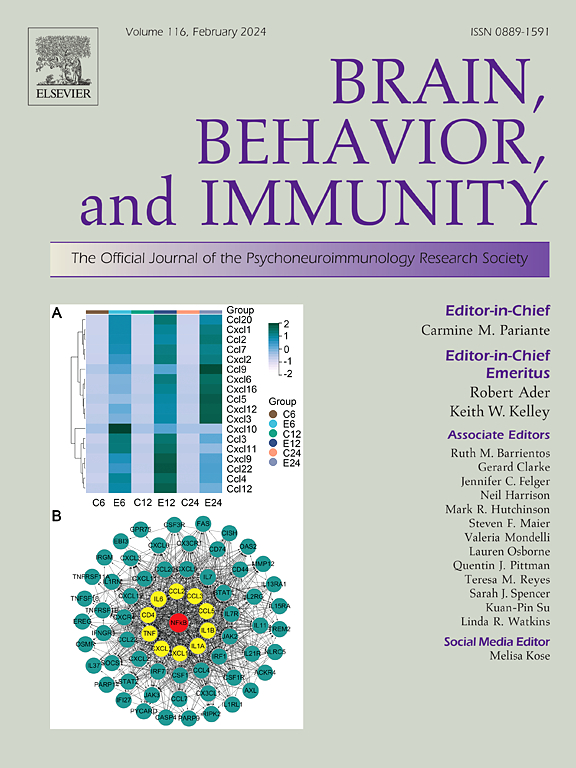儿童过敏和成年早期的焦虑/抑郁:ALSPAC出生队列的纵向研究。
IF 8.8
2区 医学
Q1 IMMUNOLOGY
引用次数: 0
摘要
背景:变态反应性疾病常与常见精神障碍并存。然而,关于儿童过敏对随后发展为焦虑或抑郁风险的纵向影响,以及可能的生物学机制,我们知之甚少。方法:我们对来自雅芳父母与儿童纵向研究(ALSPAC)出生队列的数据进行了纵向分析。基线样本包括n = 5256名7岁时有过敏数据的儿童。我们使用多变量回归来测试7岁儿童过敏与以下因素之间的关系:a) 9岁时的四种炎症标志物;B) 10-24岁之间的抑郁和焦虑测量。过敏测量包括生物标志物(总血清免疫球蛋白E (tIgE),皮肤点刺试验阳性数(SPTs)),以及湿疹、哮喘和/或食物过敏的存在(母亲报告)。炎症标志物为白细胞介素-6 (IL-6)、c反应蛋白(CRP)、IL-4和IL-13。我们使用结构方程模型来测试炎症标志物是否介导了tIgE与抑郁/焦虑之间的关联。结果:7岁时tIgE和 ≥ 1阳性SPT与9岁时IL-6水平相关(调整后β = 0.09;95 % ci 0.06-0.13;p 结论:儿童过敏的生物学标志物与IL-6相关,IL-6是关键的炎症细胞因子。然而,童年过敏可能对随后的抑郁/焦虑没有很大的长期影响。本文章由计算机程序翻译,如有差异,请以英文原文为准。
Childhood allergy and anxiety/depression in early adulthood: A longitudinal study in the ALSPAC birth cohort
Background
Allergic disease and common mental disorders frequently co-occur. However, little is known about the longitudinal impact of childhood allergy on the subsequent risk of developing anxiety or depression, and the possible biological mechanisms for this.
Methods
We performed longitudinal analyses of data from the Avon Longitudinal Study of Parents and Children (ALSPAC) birth cohort. The baseline sample comprised n = 5256 children with allergy data available at age 7yrs. We used multivariable regression to test associations between childhood allergy at age 7yrs and: a) four inflammatory markers at age 9yrs; b) depression and anxiety measures between ages 10-24yrs. Allergy measures included biological markers (total serum immunoglobulin E (tIgE), number of positive skin prick tests (SPTs)), and presence of eczema, asthma and/or food allergy (mother reported). Inflammatory markers were interleukin-6 (IL-6), C-reactive protein (CRP), IL-4 and IL-13. We used structural equation modelling to test whether inflammatory markers mediated the association between tIgE and depression/anxiety.
Results
tIgE and having ≥ 1 positive SPT at age 7 were associated with IL-6 levels at age 9 (adjusted β = 0.09; 95 % CI 0.06–0.13; p < 0.001 and adjusted β = 0.06; 95 % CI 0.03–0.09; p < 0.001 respectively), but not with CRP, IL-4 or IL13 levels. We found no strong evidence of an association between childhood allergy and subsequent depression/anxiety during adolescence and early adulthood. This finding was consistent across biological and mother-reported allergy measures.
Conclusions
Biological markers of childhood allergy are associated with IL-6, a key inflammatory cytokine. However, childhood allergy may not have a large long-term effect on subsequent depression/anxiety.
求助全文
通过发布文献求助,成功后即可免费获取论文全文。
去求助
来源期刊
CiteScore
29.60
自引率
2.00%
发文量
290
审稿时长
28 days
期刊介绍:
Established in 1987, Brain, Behavior, and Immunity proudly serves as the official journal of the Psychoneuroimmunology Research Society (PNIRS). This pioneering journal is dedicated to publishing peer-reviewed basic, experimental, and clinical studies that explore the intricate interactions among behavioral, neural, endocrine, and immune systems in both humans and animals.
As an international and interdisciplinary platform, Brain, Behavior, and Immunity focuses on original research spanning neuroscience, immunology, integrative physiology, behavioral biology, psychiatry, psychology, and clinical medicine. The journal is inclusive of research conducted at various levels, including molecular, cellular, social, and whole organism perspectives. With a commitment to efficiency, the journal facilitates online submission and review, ensuring timely publication of experimental results. Manuscripts typically undergo peer review and are returned to authors within 30 days of submission. It's worth noting that Brain, Behavior, and Immunity, published eight times a year, does not impose submission fees or page charges, fostering an open and accessible platform for scientific discourse.

 求助内容:
求助内容: 应助结果提醒方式:
应助结果提醒方式:


